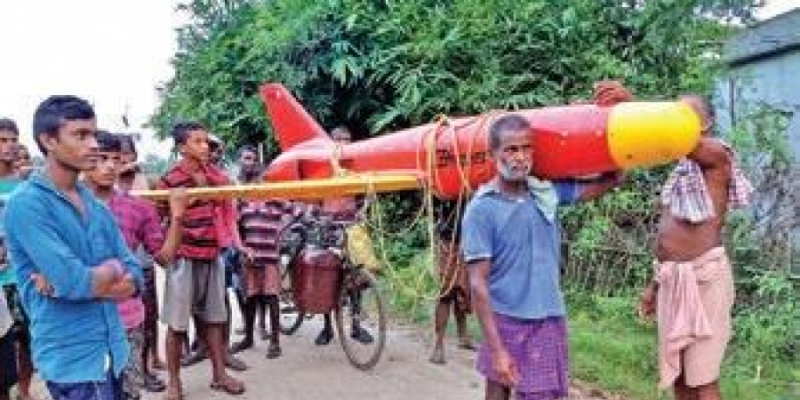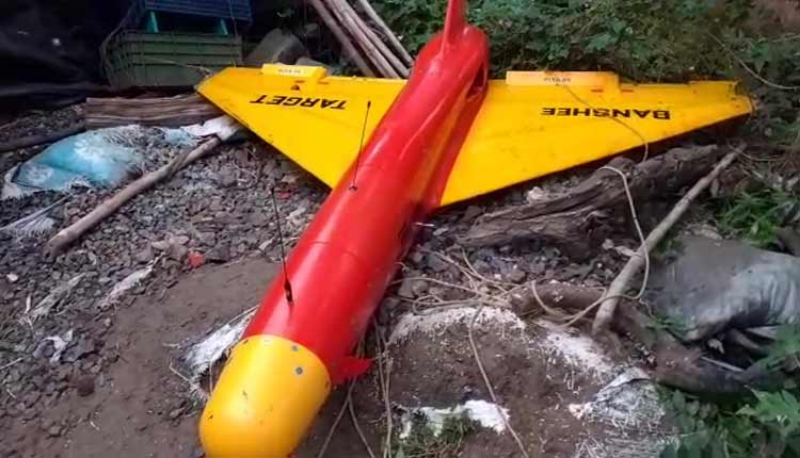Indian Fishermen Net a ‘Banshee’
Target Drone
A group of fishermen of Talapada, a nondescript village in Balasore
district, were in for a pleasant surprise after netting a prized catch,
an unmanned aerial vehicle (UAV) flight tested from the Integrated
Test Range (ITR), about 20 km from the place.
district, were in for a pleasant surprise after netting a prized catch,
an unmanned aerial vehicle (UAV) flight tested from the Integrated
Test Range (ITR), about 20 km from the place.
The British-made target drone Banshee was caught by fishermen
who had gone fishing into the deep sea. They were taken by surprise
when the target aircraft fell on their net when they were preparing to
collect fish.
“We had cast nets in the sea for our daily catch The mini
aircraft fell inside. For a moment, we thought it would
destroy our net. We slowly dragged the heavy metal
object towards our motorised boat and brought it to
the shore,” said a fisherman.
who had gone fishing into the deep sea. They were taken by surprise
when the target aircraft fell on their net when they were preparing to
collect fish.
“We had cast nets in the sea for our daily catch The mini
aircraft fell inside. For a moment, we thought it would
destroy our net. We slowly dragged the heavy metal
object towards our motorised boat and brought it to
the shore,” said a fisherman.
He said they would hand over the UAV to officials of the test range
once they arrive.
once they arrive.
Developed by Meggitt Defence Systems, Banshee is an aerial target
for surface-to-air and air-to-air weapon systems. The aircraft is
designed to float for overwater operations recovery. Its installable
options include radar enhancement devices and target sleeves. It can
simulate a sea-skimming missile or serve as a scouting UAV with a
camera.The drone’s length is about 2.84 m, wingspan 2.49 m and
height 0.86 m. It weighs around 73 kg. Travelling at a maximum
speed of 200 km/hr, it can fly nearly 75 minutes with a service
ceiling of 23,000 ft.
for surface-to-air and air-to-air weapon systems. The aircraft is
designed to float for overwater operations recovery. Its installable
options include radar enhancement devices and target sleeves. It can
simulate a sea-skimming missile or serve as a scouting UAV with a
camera.The drone’s length is about 2.84 m, wingspan 2.49 m and
height 0.86 m. It weighs around 73 kg. Travelling at a maximum
speed of 200 km/hr, it can fly nearly 75 minutes with a service
ceiling of 23,000 ft.
Defence sources said the drone was flown as part of a radar
calibration exercise of Indian Air Force (IAF). The IAF officials usually
flight test target drones to calibrate it with the radar on fighter
aircraft before going for an actual launch of an air-to-air missile.
calibration exercise of Indian Air Force (IAF). The IAF officials usually
flight test target drones to calibrate it with the radar on fighter
aircraft before going for an actual launch of an air-to-air missile.
Meanwhile, ITR Chandipur director Binay Kumar Das said that the
testing was a routine exercise carried out by the Indian Air Force
and there was no need to panic.
“It was a schedule exercise by the Indian Air Force at
Chandipur. The remotely piloted target aircraft is called
expendable aircraft which means after use it is disposed
of into the water. It is only an empty fibre body. So
usually we do not recover it.”
“We learnt that some fishermen have found it and
brought it to the shore. There is no harm in it and
no need to worry as it was part of a routine exercise,”
he said.
testing was a routine exercise carried out by the Indian Air Force
and there was no need to panic.
“It was a schedule exercise by the Indian Air Force at
Chandipur. The remotely piloted target aircraft is called
expendable aircraft which means after use it is disposed
of into the water. It is only an empty fibre body. So
usually we do not recover it.”
“We learnt that some fishermen have found it and
brought it to the shore. There is no harm in it and
no need to worry as it was part of a routine exercise,”
he said.
Speaking about the objective behind carrying out such trials, Das
said, “We carry out such exercise to check our capabilities in
destroying the enemy targets when the fighters used by Indian Air
Force go into war.”
said, “We carry out such exercise to check our capabilities in
destroying the enemy targets when the fighters used by Indian Air
Force go into war.”





Ingen kommentarer:
Legg inn en kommentar
Merk: Bare medlemmer av denne bloggen kan legge inn en kommentar.